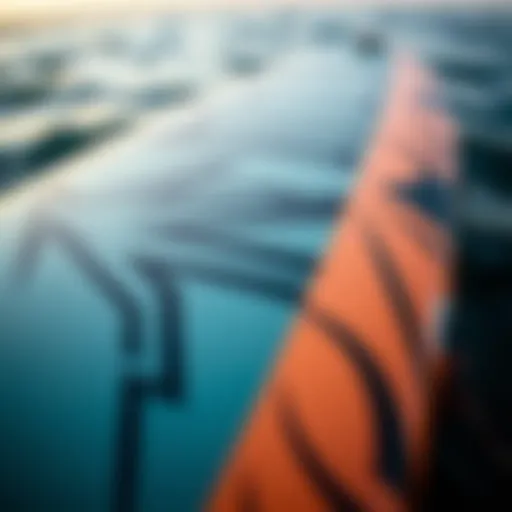GoPro Surfboard Mounts: Capture Your Surfing Adventures
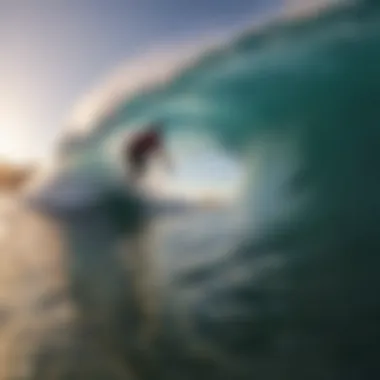

Intro
In the exhilarating world of surfing, capturing the perfect wave is often a fleeting moment, sometimes slipping away faster than the swell itself. This is where GoPro surfboard mounts come into play, acting as both a tool and a companion for surfers seeking to immortalize their rides on film. The remarkable clarity and wide-angle capabilities of GoPro cameras enhance the storytelling of each surf session, allowing moments of adrenaline, skill, and pure joy to be relived time after time.
As we delve into the various aspects of these mounts, we aim to present a detailed guide that covers installation tips, specific advantages they offer, and considerations that every surfer, regardless of experience level, should take into account. The aim is to provide all the know-how for utilizing this technology in harmony with the ocean's unpredictable rhythms, while also emphasizing safety and respect for the surf environment.
In a landscape populated by many different surfboard models and a variety of mounting options, it's crucial to navigate these waters with clarity. Whether you’re a novice still finding your footing, or a seasoned wave-rider honing your craft, understanding the nuances of GoPro surfboard mounts can elevate your surfing experience to new heights. This narrative is crafted for instructors, beach lifeguards, outdoor writers, and marine biologists, aiming to bridge the gap between technology and nature in a meaningful way.
To get started, we’ll look at the essential aspects of surfboards—understanding their types and selecting the right one for your needs can dramatically affect how the GoPro integrates into your surfing style.
Surfboard Reviews
Types of Surfboards: An Overview
When standing on the precipice of a wave, the right surfboard can be your best ally. Surfboards come in various shapes and sizes, each crafted for specific conditions and surfing styles. Here’s a quick breakdown of some predominant types:
- Shortboards: Agile and responsive, these boards belong to high-performance surfers looking to carve tight turns and pull off tricks.
- Longboards: Characterized by their stability and length, longboards suit beginners and those who enjoy a more laid-back style, embracing the classic ‘nose riding’ techniques.
- Fish Boards: With their distinct width and shorter length, fish boards excel in smaller, choppier waves, making them perfect for surfers who seek maneuverability.
- Funboards: A blend of short and longboards, funboards accommodate those just stepping into surfing and cater to intermediate surfers looking for a versatile option.
Understanding these types lays the groundwork for choosing a board that complements both your skill level and intended filming style with a GoPro.
Best Surfboards for Beginners and Pros
Whether you are a newbie hoping to catch your first wave or an experienced surfer pushing through complex maneuvers, selecting the right surfboard is crucial. Here are recommendations categorized for both groups:
For Beginners:
- Soft-top Surfboards: These boards balance stability and safety. The soft top prevents injury during falls.
- Longboards: Their length offers great balance, helping beginners paddle efficiently and catch waves easier.
For Pros:
- Performance Shortboards: Made for agility and speed, these are optimal for advanced tricks.
- Hybrid Designs: They combine elements from different styles, providing pros with versatility and adaptability for various conditions.
"The best ride is only as good as your surfboard—know what fits you, and you’ll conquer any wave."
In our next section, we’ll discuss essential surfing techniques that complement your equipment choice and elevate your overall experience. By blending what you learn about surfboards with effective techniques, you’ll pave the way toward capturing that perfect footage effortlessly.
Stay tuned for a deeper dive into skills that correlate with your equipment, as well as how to best utilize GoPro mounts for immaculate surf footage.
Understanding the GoPro Surfboard Mount Concept
When it comes to combining the thrill of surfing and cutting-edge technology, grasping the concept of GoPro surfboard mounts is vital. Surfboard mounts position an action camera securely to capture every twist and turn during an epic ride. By understanding their purpose and functionality, surfers across all levels can maximize their experience on the waves.
What Is a Surfboard Mount?
A surfboard mount is a specially designed accessory that attaches a GoPro camera to the surfboard. Using these mounts enables surfers to record their sessions from unique perspectives—providing both visual documentation of their skills and exhilarating surf moments.
There are various types of mounts available, such as:
- Adhesive mounts: The most common type, these utilize a strong adhesive to attach directly to the board.
- Clamp mounts: These offer flexibility by clamping onto the board, allowing for repositioning.
- Fins with integrated mounts: This innovative design combines a fin and mount to streamline setup.
The key benefit of utilizing surfboard mounts is the ability to capture dynamic footage without the hassle of holding a camera. With hands free, surfers can focus entirely on the waves, enhancing both performance and enjoyment.
Historical Context of Action Cameras in Surfing
The relationship between action cameras and surfing dates back to when early pioneers, intrigued by the prospect of filming their exploits, began experimenting with various devices. Initially, the quality and capability of available cameras were limited. As technology improved, cameras like the GoPro came onto the scene, catering specifically to adrenaline-driven sports, surfing included.
From their inception, these action cameras provided surfers with a whole new way to visualize their performance, allowing instant playback for review. Surfers started capturing highlights of their time in the water, enabling them not just to relive the high-flying moments but also to analyze their technique. This helped carve a niche for GoPro in surf culture, as surfers began sharing their videos across social media platforms. Seeing stunning shots of friends ripping through the surf became commonplace, changing the expectation of what a surf session might look like.
Importance in the Article
The examination of GoPro surfboard mounts and their historical significance underpins the entire article. By highlighting how technology has evolved, the current benefits are situated in a broader narrative. As surfers become more adept at capturing their thrilling rides, understanding the nuances of these mounting options can amplify their experience, ensuring that they make wise choices in equipment selection. This exploration encourages both casual beachgoers and dedicated athletes to embrace the potential of modern technology while engaging with their passion for surfing.
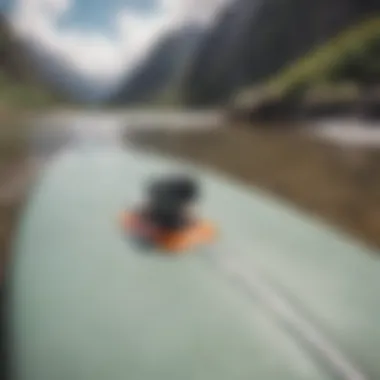

Benefits of Using a GoPro Mount for Surfing
Using a GoPro mount while surfing takes the sport to a whole new level. It's not just about capturing those killer waves; it’s also about understanding your style, improving your skills, and ensuring safety. For surfers at any level—whether you’re a greenhorn or a seasoned pro—a GoPro surfboard mount opens up myriad possibilities.
Capturing High-Quality Surf Footage
One of the greatest perks of mounting a GoPro on your surfboard is the ability to capture high-quality footage. Think about it: being able to film your every ride, maneuver, and wipeout means you can relive those adrenaline-fueled moments any time you want. The latest GoPro models boast impressive stabilization features which help eliminate the shakiness that can often plague action shots. This means that whether you're shooting mellow waves at your local beach or tackling gnarly swells at a far-off reef, your footage can look smooth and professional.
Not only does this allow you to cherish your surfing moments, but it can also help you share your experiences with others. Posting jaw-dropping surf videos on platforms like Facebook or Reddit can garner appreciation from the surf community and inspire fellow surfers.
Enhancing Technique Analysis
Beyond just capturing thrilling imagery, GoPro mounts serve another valuable purpose: they enhance technique analysis. With the ability to review your rides after a surf session, you can critically evaluate your form, positioning, and wave-catching strategies. For instance, a session filmed from the right angle allows you to see how you're executing turns and how your weight distribution affects your balance on the board.
"Reviewing footage brings clarity that on-the-water feedback simply can’t provide."
Being able to analyze footage is like having a personal coach, without the hefty price tag. Many surfers use these insights to adjust their techniques, which can lead to noticeable improvements over time. Let’s face it—when you can see the mistakes, it becomes a lot easier to correct them.
Promoting Safety Through Visibility
When it comes to ocean sports, safety can't be understated. One often overlooked benefit of affixing a GoPro to your surfboard is the safety aspect it represents. Visibility in the water is paramount, particularly when waves kick up to enormous heights or when you’re surfing in crowded waters. A brightly colored GoPro mount can help you stand out, making it easier for fellow surfers and lifeguards to spot you.
Moreover, if you're surfing in remote areas or during less-than-ideal conditions, having recorded footage serves as a form of accountability and safety. If something goes awry, the footage may provide vital information about your condition, location, and situation.
Thus, using a GoPro not only helps you capture your thrilling exploits but also plays an influential role in surfing safety, offering a safety net while you chase the waves.
In essence, the benefits of using a GoPro mount while surfing are multifaceted. From capturing heart-stopping footage to offering a lens through which to improve your skills, the integration of this technology in surfing cannot be understated.
Selecting the Right GoPro Mount for Your Needs
Selecting the appropriate GoPro mount can make a world of difference in your surfing experience. It goes beyond simply attaching a camera to your board; it’s about how you can optimize your filming, capture unique perspectives, and ensure the mount takes the rough and tumble of waves and saltwater without flinching. A well-chosen mount aligns perfectly with your personal surfing style and the conditions you frequently surf in.
When considering which mount to select, think about the types of shots you aim to capture. Are you seeking aerial views, point-of-view (POV) angles, or perhaps side shots while riding those gnarly waves? Each type of mount is tailored for specific conditions and desired footage which enhances the entire surf filming experience. Furthermore, ensuring that your chosen mount integrates seamlessly with both your surfing and camera setup is essential.
Types of GoPro Surfboard Mounts
There are various types of GoPro surfboard mounts to choose from, each designed for different filming angles and personal preferences. Some common options include:
- Front Mount: Best for capturing that thrilling point-of-view shot as you ride the wave. This mount provides a sense of immersion, making viewers feel as though they are right there on the board.
- Side Mount: Ideal for getting a perspective of both you and the ocean. It allows for excellent framing, especially during turns or when executing maneuvers.
- Chest Mount: This is perfect if you want to capture your actions and reactions simultaneously. By mounting on your chest, you get an engaging perspective that includes body movements and facial expressions.
- Wrist Mount: Great for hands-free recording while you paddle — ideal for diversifying angles without hassle.
Regardless of the option, ensuring that your mount allows for easy adjustments is key, so you can quickly adapt to changing surf conditions.
Material Considerations for Durability
Durability is a major factor in the selection process. Surfing involves unpredictable elements, and gear needs to withstand crashing waves, sun exposure, and rough handling. Here are a few considerations to keep in mind when evaluating materials:
- Plastic vs. Metal: Although metal offers strength, lightweight plastic options may be more suitable for boards to minimize weight. Many users opt for high-quality plastics that resist wear and are water-resistant.
- Grip and Adhesion: If the mount utilizes adhesive pads, ensure they have high friction and can withstand saltwater and sand. A mount that peels off mid-ride can lead to losing valuable footage and the camera itself.
- Water Resistance: Look for mounts designed to resist corrosion. Saltwater can degrade materials over time, causing mounts to fail when you rely on them most.
Choosing a dependable mount made from quality materials will not just protect your equipment but also enhance the overall experience of capturing your surf adventures.
Compatibility with Different GoPro Models
Compatibility with different GoPro models is essential for an efficient filming setup. Not every mount fits every GoPro camera, so before making a purchase, you should research the specifics. Here are some points to factor:
- Mounting Systems: For instance, the GoPro Hero 9 has a different mounting system compared to earlier models like the Hero 5. Some mounts may only fit newer camera versions, so confirm before you buy.
- Weight: Make sure your chosen mount can handle the weight of your camera model. Heavier models might require sturdier mounts that can endure the force of waves and impacts.
- Feature Compatibility: Advanced features, such as HyperSmooth stabilization present in later GoPro models, can be compromised if not paired with the appropriate mount. Check that your mount preserves the camera functionality necessary for quality filming.
By carefully considering the options available in GoPro surfboard mounts, you’ll be better positioned to enhance your overall surfing experience. After all, the right equipment can turn a good day on the waves into an unforgettable memory captured in stunning footage.
Installation Process of GoPro Mounts
Installing a GoPro mount on your surfboard isn’t just a mere task; it’s the first step towards capturing those breathtaking moments as you ride the waves. The process may appear straightforward at its core, but it demands attention to detail and some careful considerations to ensure that your camera will be secure and effectively record your adventures. By grasping the installation process, surfers can prevent potential mishaps that might not only ruin a recording but also potentially damage valuable equipment. With the ocean’s unpredictable nature, ensuring that your mount is installed properly is paramount.
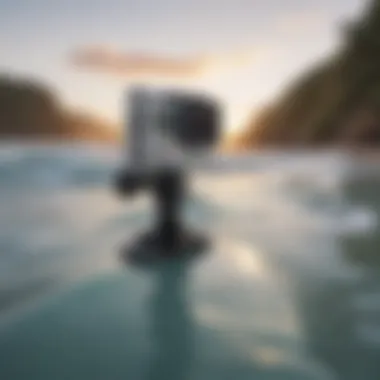

Step-by-Step Guide to Mounting
Installing your GoPro mount correctly can make the difference between a robust setup and one that falters during an epic run. Here’s how to go about it with clarity and precision:
- Gather Your Supplies: Make sure you have your GoPro, the mount kit, and any tools that may be necessary, such as a small wrench or screwdriver if needed.
- Choose the Right Location:
- Clean the Surface: A smooth and clean surface is essential for a strong bond. Use rubbing alcohol to wipe down the area where you’ll place the mount. Let it dry completely before proceeding.
- Position the Mount: Take your time to position the mount precisely. You might want to test different angles by temporarily placing it without sticking it down to see where the filming best captures your surroundings.
- Apply the Adhesive: Most mounts come with 3M double-sided adhesive. Peel off the backing and stick it down firmly, applying even pressure for an effective bond.
- Secure the Mount: Allow at least a couple of hours for the adhesive to bond properly before attaching the GoPro. This will ensure a firmer hold.
- Attach Your Camera: Once the mount is set, snap your camera onto the mount and give it a test shake to ensure it’s firmly locked in.
- You want the mount to be placed in a spot that captures the best angles possible. Usually, the deck of the board is the best choice, avoiding any position where it might obstruct your stand.
- Consider the direction of the waves and how you typically ride.
- Tip: If you're mounting in cold water conditions, you might want to warm the adhesive slightly by rubbing it to enhance stickiness.
Following these steps carefully can help assure that your GoPro is safe and sound while you conquer the waves.
Common Mistakes in Installation
Even seasoned surfers can hit bumps in the road when it comes to mounting a GoPro. Here are some common missteps that can lead to mishaps and how to avoid them:
- Skipping the Cleaning Step: Not cleaning the board’s surface can lead to a weak bond. Dirt or wax residues may interfere with adhesive strength, making your mount prone to failure.
- Improper Placement: Placing the mount too close to the tail or nose of the board can make it susceptible to dings or damage. Make sure the camera is positioned where it won’t obstruct your movement or easily get snagged in the water.
- Neglecting Weather Conditions: Installation on a wet board or in humid conditions can compromise the adhesive. It’s best to plan for dry conditions, ideally around 100°F or more.
- Forgetting to Test: After attaching the GoPro, not performing a quick shake test can leave you unaware of any loose fittings until it’s too late. Testing the equipment ensures everything is snug before heading out.
Remember: The goal is to enjoy those extraordinary moments in the ocean without the anxiety of a camera mishap!
By following a meticulous installation process and being aware of common pitfalls, surfers can fully enjoy their sessions while capturing every thrilling ride with confidence.
Optimizing Video Capture While Surfing
When it comes to capturing the perfect wave, the way you optimize your GoPro's video settings can significantly change the quality of your footage. Surfing is not only about the thrill of riding the waves, but also about telling your story through those waves. A well-optimized video setup ensures that every splash, turn, and moment of exhilaration is immortalized flawlessly.
Camera Settings for Different Conditions
Surfers often encounter varied conditions, from bright sunlight glaring off the ocean to low-light challenges during early morning sessions. Choosing the right camera settings can act like a lifebuoy thrown in the water during a storm. Here are some essential settings to keep in mind:
- Resolution: 4K provides stunning clarity, but if you're low on storage or looking for longer continuous recording, 1080p is a solid compromise.
- Frame Rate: A higher frame rate, such as 60fps or even 120fps, can capture fast movements smoothly. This adds a cinematic quality to your footage, ideal for those high-speed rides.
- Field of View: Depending on your style, you might want to choose between wide or linear view. While a wide angle captures more of the environment, the linear reduces distortion, making your shots appear more natural.
- Low Light Performance: Enabling the low-light mode can help in dimmer conditions. This alters the exposure levels for better visibility when the sun isn’t cooperating.
Tip: Always test your settings before hitting the water. A few dry runs in varied lighting can reveal any adjustments needed.
Angles and Perspectives for Impactful Shots
The angle at which you capture your surfing adventures can drastically affect how engaging the video appears. It's like choosing to stand on the beach, or right in the heart of the turmoil; the perspective can change everything. Here are some compelling angles to consider when mounting your GoPro:
- Board Level Shots: Getting the camera right near the water’s surface not only captures the waves beautifully but also offers a unique view of the board, immersing viewers in the experience.
- Chest Mount: This position provides a first-person perspective that makes viewers feel as if they are riding the wave themselves, even if they are sipping coffee on a couch.
- Rooftop Mount: If you're feeling adventurous, try placing the camera on the back of your board. It can yield incredible shots of waves breaking and your maneuvers above the water.
- Drone Shots: Though a bit cumbersome, incorporating drone footage can elevate your footage to majestic heights, showing not only the surfer but the beautiful coastal scenery.
Remember: Experimenting with different angles can takes your footage from mundane to cinematic. The more you play, the better you'll understand what works best for your style and the conditions you face.
Ultimately, optimizing video capture while surfing is about finding the balance between technical specifications and your unique vision as a surfer. Each wave is a new opportunity to craft a story that goes beyond just catching a ride.
Maintenance and Care for GoPro Equipment
Taking proper care of your GoPro equipment is as vital as choosing the right mount or setting up the perfect shot. Maintaining both the camera and its mounts ensures longevity, optimal performance, and, most importantly, safety while you're out on the waves. Neglecting this aspect can lead to disappointing footage and potential malfunction when you need your gear most.
Cleaning and Storage Recommendations
When it comes to cleaning your GoPro, it’s not just a matter of giving it a once-over. Saltwater, sand, and dirt can wreak havoc on the camera’s sensitive components and outdoor mounts.
- Rinse After Use: After a surf session, rinse your GoPro and mount under fresh water. This simple step helps remove salt and sand that can corrode parts over time.
- Use a Soft Cloth: For both the lens and the body, opt for a soft microfiber cloth to wipe away residue. Avoid paper towels and not so soft cloths, as they can scratch the surface.
- Check the Seals: Inspect the waterproof seals regularly. Debris can compromise their integrity, leading to water damage.
- Proper Storage: When you’re not out riding the waves, store your GoPro in a cool, dry place. A dedicated case, like those made by GoPro, is ideal. It keeps dust away and protects the device from sudden impacts.
"Regular maintenance prevents small issues from turning into expensive repairs or replacements."
Troubleshooting Common Issues
Even the best equipment can throw a fit from time to time. Troubleshooting common issues can save you precious time, especially right before a surf session. Here are steps typically helpful for resolving frequent problems:
- Battery Drain: If your GoPro's battery drains unusually fast, check if it's running heavy applications in the background. Disable Wi-Fi and GPS when not in use to extend battery life.
- Overheating: If the camera gets too hot, it may shut down. Avoid direct sunlight for prolonged periods and let it cool down before using again.
- Video Quality Issues: Ensure you are recording in the correct settings. Low-light conditions often require setting adjustments.
- Mount Stability: If footage is shaky, double-check the mount's adhesive. An improperly adhered mount can shift while surfing. Always watch for signs of wear on the adhesive pad; replace it when necessary.
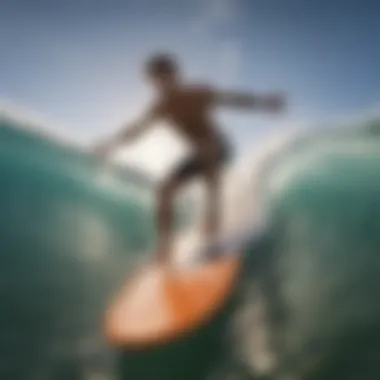

In summary, maintaining your GoPro equipment is crucial for maximizing your surf experience. By cleaning and storing it properly and knowing how to address common issues, you can ensure that every session is documented flawlessly.
Safety Considerations in Surf and Technology Use
When it comes to surfing, the thrill and joy are predominant. Yet, integrating technology like GoPro mounts brings a host of safety considerations that cannot be overlooked. By evaluating the relationship between surfing and tech, it becomes clear why safety should be a foremost concern for anyone looking to capture their wave-riding exploits.
Ethics of Filming in Ocean Sports
Filming in ocean sports, especially with a tool like the GoPro, raises important ethical questions. Surfers who wish to record their rides often share the water with others, and this shared space demands consideration and respect. Just because you have a camera does not grant you the right to invade someone else's ride or their personal space. Moreover, there are unspoken rules about filming, particularly concerning competitive events or crowded breaks where filmers must be cautious not to obstruct the view of other surfers.
A good guideline for ethical filming is to constantly be aware of your surroundings. Keep your camera ready but maintain a respectful distance from others. This practice not only promotes a harmonious surf environment but also lessens the risk of accidents that arise from careless recording.
It's also essential to think about the implications of what you are sharing. Posting footage that could compromise the safety or privacy of others could lead to conflict or unwanted attention. Always seek consent from fellow surfers before featuring them in your videos. Just because you have footage doesn’t mean you should share it liberally.
"Respect the waves and those who ride them—filming is a privilege, not a right."
Minimizing Distractions While Surfing
Surfing demands focus and awareness; it's a dance between the ocean and the rider. Yet, when technology enters the picture, distractions can easily emerge. The desire to capture the perfect wave can lead to a lapse in concentration, putting both the surfer and others at risk. To minimize these distractions, it's vital to compartmentalize your time.
Consider limiting your filming to specific sessions or certain waves, so you don’t get carried away with filming every ride. Here are some tips for maintaining focus while using technology:
- Practice Beforehand: Spend time ensuring you’re comfortable with your equipment. Fiddling with a camera while trying to catch a wave can be hazardous.
- Understand Your Surroundings: Be aware of wave patterns and the surfers around you. Not every moment is suitable for capturing; knowing when to put the camera down can save a lot.
- Use Quick Controls: Familiarity with the quick-access functions on your GoPro allows you to adjust settings without taking your eyes off the surf.
- Stay Mindful: Always reassess your priorities on the water. Remember, safety comes first. The tech should serve you, not distract you.
Incorporating technology into surfing should never compromise safety or respect for others. Thoughtful consideration of the ethics of filming and actively minimizing distractions can ensure that while you capture stunning footage, you also maintain the essence of what makes surfing incredibly rewarding.
Insights from Professional Surfers
Incorporating the perspectives of professional surfers into this discussion brings to light the crucial relationship between technology, safety, and performance in surfing. These experts, often riding the biggest waves and competing at high levels, provide a unique vantage point on how GoPro surfboard mounts can enhance the overall surfing experience. By diving into their insights, we can understand not only how to effectively utilize this technology but also the intrinsic values this brings to the surfing community.
Recollections of Memorable Sessions
Professional surfers frequently recall unforgettable sessions where recording their experiences with a GoPro enhanced their connection to both the sport and their audience. For instance, a renowned surfer might share a story about capturing their first wave after a significant injury. The footage not only highlighted the triumph of returning to the sport but also inspired countless fans watching from around the globe. This kind of storytelling becomes an emotional bridge between the surfers and their followers, showcasing the raw beauty of the ocean and the challenges faced during those moments.
Moreover, many surfers mention how reviewing their footage has helped them perfect their technique. Analyzing the angle taken on a wave or the form maintained during a maneuver can lead to significant improvements. Having the ability to review these moments allows surfers to adjust their performance, honing their skills in a way that traditional reviews or coaching sessions simply cannot achieve.
Advice on Using Technology Responsibly
As much as technology can enrich the surfing experience, professional surfers also emphasize the importance of using it responsibly. They advocate for being aware of one’s surroundings while filming, which is paramount given the unpredictable nature of ocean waves and currents. To put it bluntly, focus should be on the wave, not just the camera.
Some pointers include:
- Stay Alert: Always keep an eye on fellow surfers and the environment, ensuring that capturing footage doesn’t impede safety.
- Limit Distractions: Avoid fiddling with settings mid-session. Preparation before hitting the water is key.
- Respect Privacy: If others are in the line-up, consider whether it’s appropriate to film them without consent. This keeps the surf community’s camaraderie intact.
- Educate: Use footage as a tool to teach others about safety and technique, sharing insights rather than glorifying risky behaviors.
"It's not just about nailing the shot; it's about sharing the love for the ocean responsibly," notes a seasoned surfer during a recent workshop on responsible filming.
Through responsible use of GoPro mounts, surfers not only enhance their personal experience but also contribute positively to the broader surf culture, ensuring that technology serves to uplift rather than distract from the sport.
Future Trends in Surf Technology
In the ever-evolving world of surfing, technology plays a huge role in enhancing performance, safety, and overall experience. As surfers increasingly seek out quality storytelling through video, the integration of tech, especially with devices like GoPro, becomes paramount. The future trends in surf technology reflect changing needs and aspirations of surfers. This is not just about better cameras or mounts; it's about how these advancements will connect surfers with their passion and each other.
Advancements in Camera Technology
When it comes to capturing those breathtaking moments on the wave, the evolution of camera technology is exciting. Gone are the days of bulky cameras that lag behind. Today, compact devices boast stunning image stabilization features that keep footage smooth even when the waters get wild. The latest GoPro models come equipped with higher resolutions, allowing surfers to shoot in 4K or even 8K, offering sharp clarity that is simply mind-blowing.
Surfers can expect:
- Improved Low-Light Performance: Surfers often find themselves waiting for the perfect conditions at dawn or dusk. Newer camera technology addresses this by enhancing the capabilities to capture clearer pictures in lower light conditions, allowing for those magical sunrise or sunset sessions to be captured in all their glory.
- Integrated Sensors: The future will likely see cameras that come with sensors that can analyze water conditions, wave heights, and even pressure systems, providing surfers with real-time feedback.
- AI Features: Artificial Intelligence is making waves with automatic editing options that can combine footage into highlight reels in a matter of minutes. With smart editing features, surfers can spend less time behind the screen and more time in the water.
Potential Developments in Surfboard Mounts
As camera technology advances, the surfboard mounts themselves are also set to evolve. Mounting technology is crucial for ensuring that devices remain secure while catching all the action a surfer encounters. Current mounts are just a taste of what’s to come. Let's consider the possibilities:
- Modular Mounting Systems: Picture a future where mounts can easily be adapted or changed on-the-fly. This would allow surfers to transition from one mount type to another within seconds, providing flexibility when capturing different angles or perspectives.
- Enhanced Adhesives and Materials: Future mounts will likely use advanced materials that are both lighter and stronger. This means even in the most turbulent waters, your camera stays put. Imagine a mount made from a thermoplastic elastomer that’s resistant to salt and UV damage; it could revolutionize the way we think about durability in sports gear.
- Bluetooth Integration: Expect mounts that can remotely connect with your GoPro, letting surfers control recording settings hands-free. This integration opens avenues for more spontaneous shooting, as surfers can focus on riding the waves rather than fussing with buttons.
As technology advances, these changes will inevitably enhance the way we capture and share our surfing experiences. They give new generation of surfers the opportunity to document their journeys while also promoting safety and community engagement within the sport. Ultimately, the future of surf technology is not just about achieving the perfect shot; it's about fostering connections and memories that last a lifetime.















